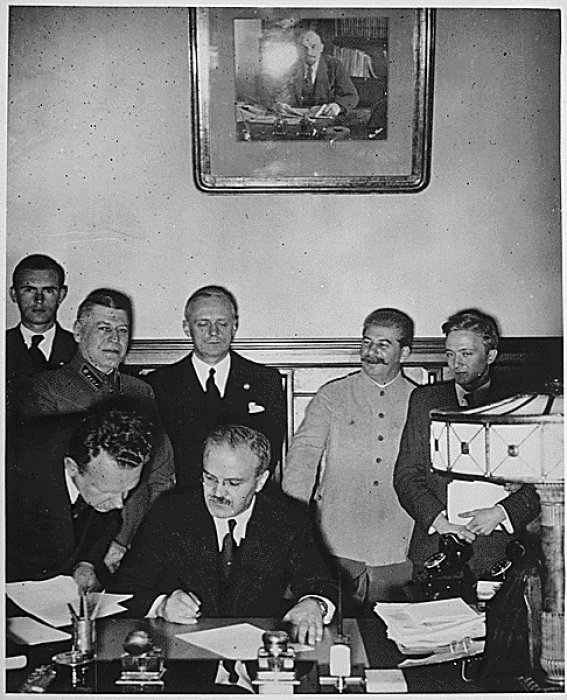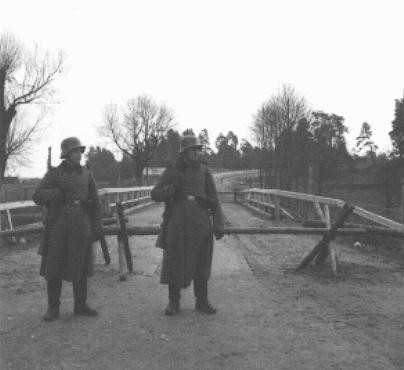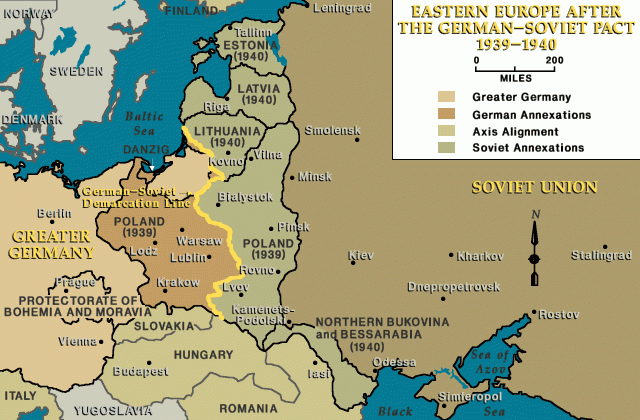
German-Soviet Pact
The German-Soviet Pact was signed in August 1939. It paved the way for Nazi Germany and the Soviet Union to invade and occupy Poland that September. The pact was an agreement of convenience between two bitter enemies. It permitted them to carve up spheres of influence in eastern Europe, while pledging not to attack each other for 10 years. Less than two years later, however, Hitler launched an invasion of the Soviet Union.
Key Facts
-
1
This agreement is commonly referred to as the Molotov-Ribbentrop Pact. It is also known as the Nazi-Soviet Pact or the Hitler-Stalin Pact.
-
2
The arrangement included a 10-year non-aggression pact between Germany and the Soviet Union. It also called for economic cooperation and territorial expansion.
-
3
The German-Soviet Pact prepared the way for World War II.
The German-Soviet Pact was an agreement signed by Nazi Germany and the Soviet Union on August 23, 1939. German Foreign Minister Joachim von Ribbentrop and Soviet Foreign Minister Vyacheslav Molotov negotiated it. The pact goes by several names: German-Soviet Pact, Molotov-Ribbentrop Pact, Nazi-Soviet Pact, and Hitler-Stalin Pact.

The German-Soviet Pact consisted of two parts, one public and one secret. The public part was a non-aggression pact in which each country promised not to attack the other. They also agreed not to provide assistance to a third country that attacked either of them. In addition, Nazi Germany and the Soviet Union agreed not to participate with other countries in an arrangement that would affect the other, directly or indirectly. The non-aggression agreement was to last for ten years. It could be automatically renewed for an additional five years if neither party moved to end it.
The secret part of the pact was a protocol that established Soviet and German spheres of influence in eastern Europe. Estonia, Latvia, and Bessarabia fell within the Soviet sphere, according to the protocol. The signatories agreed to divide Poland along the line of the Narev, Vistula, and San rivers.
The German-Soviet Pact in Action
With the pact in effect, Germany attacked Poland on September 1, 1939, without fear of Soviet intervention. On September 3, Britain and France declared war on Germany. They were fulfilling a promise they had made five months earlier to protect Poland’s borders. On September 17, the Soviet Union invaded Poland from the east. These events mark the beginning of World War II.
Germany and the Soviet Union then moved to take control of the spheres of influence outlined in the secret protocol. They amended the protocol so that Lithuania and the city of Vilnius (then Wilno, Poland) fell within the Soviet sphere. They also adjusted the boundary they had set in Poland. On September 29, 1939, they partitioned Poland between them. Germany occupied western and most of central Poland. It proceeded to annex the western provinces to the Reich. The Soviet Union occupied and annexed the rest of Poland.
The German-Soviet Pact enabled the Soviet Union to annex other territories in its sphere of influence. On November 30, 1939, the Soviets attacked Finland. After a four-month war, they annexed Finnish territory along the Soviet border. This territory included the area near Leningrad (now St. Petersburg). In the summer of 1940, the Soviets occupied and incorporated the Baltic states of Estonia, Latvia, and Lithuania. They also seized the Romanian provinces of Northern Bukovina and Bessarabia.

The End of the German-Soviet Pact
Hitler regarded the German-Soviet non-aggression pact as a tactical and temporary maneuver. He never intended to uphold the terms of the agreement for ten years. His long-range plan was for German forces to attack the Soviet Union and establish Lebensraum (living space) for the Germans in the territories they seized. Before taking this step, however, Hitler intended to subdue Poland and defeat France and Great Britain. The non-aggression pact allowed Germany to focus on those goals without fear of a Soviet attack. The pact enabled Nazi Germany to avoid war on two fronts—western and eastern—for a while.
In July 1940, one month after Germany defeated France, Hitler ordered preparations for war against the Soviet Union. German diplomats worked to secure Germany's flank in southeast Europe. In November 1940, Hungary, Romania, and Slovakia joined the Axis alliance. During the spring of 1941, Hitler initiated his European allies into plans to invade the Soviet Union.
On December 18, 1940, Hitler signed Directive 21 (code-named “Operation Barbarossa”). This directive was the first operational order for the invasion of the Soviet Union. From the time they began planning the invasion, German military and police authorities intended to wage a war of annihilation. They considered their enemies to be the Soviet Union’s “Judeo-Bolshevik” Communist government as well as Soviet citizens, particularly the Jews.
On June 22, 1941, German forces invaded the Soviet Union. This marked the end of the German-Soviet Pact. It had lasted for less than two years.
Critical Thinking Questions
Investigate German-Soviet relations from WWI until 1939.
Why was the signing of this pact a surprise to many observers?
How long was this pact in effect? When did it end? Why?
Why are treaties signed and/or broken?

